Editor’s Note: This article was first published in 2015. Given the fact that eggs are one of the most important protein sources, everyone should consider adding them to their stockpile. I believe this information will be helpful to people who didn’t get a chance to read the article when it was initially posted.
Powdered Eggs are cheap, lightweight, nutritious and can last up to 10 years without refrigeration. If it weren’t for their lack of Vitamin C, (nutritionally) a person could basically subsist for years only on powdered eggs.
Powdered eggs should be stored in the absence of oxygen and humidity (vacuum sealed) and placed in a cool dark place. Once a container of powdered eggs has been opened, the shelf life is comparable to any other dehydrated dairy product (approx. one month).
They can be used in baked goods just like normal eggs or reconstituted and made into fluffy scrambled eggs. To reconstitute one egg (for example) mix 1 heaping Tablespoon Powder with one Tablespoon cold water and one Tablespoon Milk (water – if you don’t have milk). Then you put it in the blender for a few seconds, and cook as you usually do. This procedure takes most of the grainy out.
But you don’t have to be a prepper to make powdered eggs. For instance, if you’ve got a chicken coop and you have too many eggs at a time, powdering the extra eggs would be an excellent option. When the hens are not laying, the stored powder will be useful.
Related: How To Choose, Use & Store Protein Powder for Preppers
At last it is done. I am not ashamed I had to take the advise of my Mom but in the end, I now have my own Powdered Eggs.
To start off I will tell you what I was doing wrong:
- My first batch never dried and came out just oily clumps of nasty eggs because I used butter in the pan and added all the seasonings.
- The second batch turned into little rubber balls because I used the oven to dry them and set it on too low of a temp for way too long.
- The third batch never dried even after two days because I was using the wrong kind of Dehydrator. It did not have a fan in it.
- The fourth batch I went back to using the old 1970’s model dehydrator but they never dried all the way because my pieces were too big.
- This is the batch Momma told me how to do it and they came out just fine. Here is what I did.
1. Without using anything in the nonstick pan, I cooked the scrambled eggs until all visible moisture was gone and then a little more. During the cooking process I chopped the eggs up as small as I could so the heat would cook the moisture out.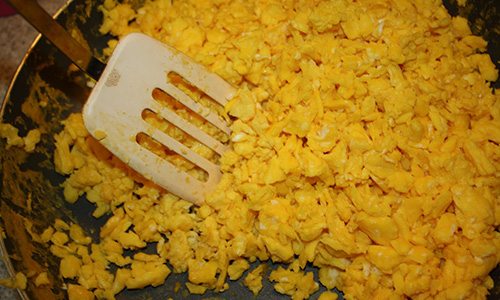 2. Then I put all the eggs into a food processor and chopped them as small as they would go. This is one of the steps I did not do before.
2. Then I put all the eggs into a food processor and chopped them as small as they would go. This is one of the steps I did not do before.
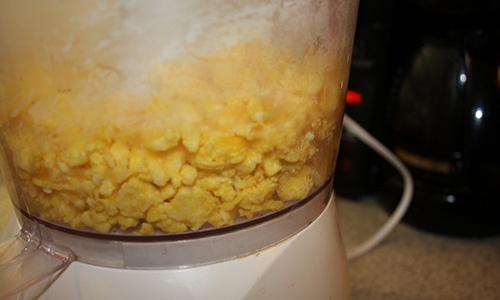 3. Right out of the food processor and right on the dehydrator tray they went.
3. Right out of the food processor and right on the dehydrator tray they went.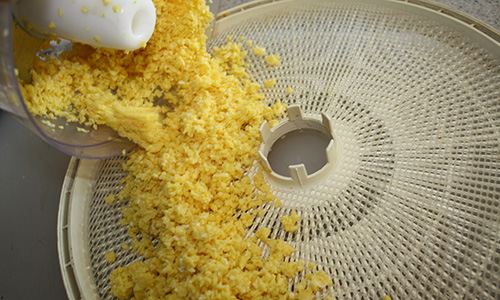 4. I spread the cooked and finely chopped eggs evenly all over the tray. Eighteen eggs should fill up two trays.
4. I spread the cooked and finely chopped eggs evenly all over the tray. Eighteen eggs should fill up two trays.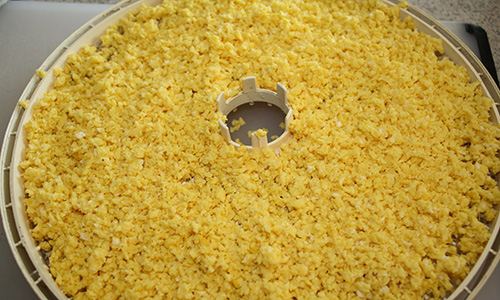 5. The dehydrator was set on 145 degrees overnight. The end result was crispy burnt orange egg crumbles.
5. The dehydrator was set on 145 degrees overnight. The end result was crispy burnt orange egg crumbles.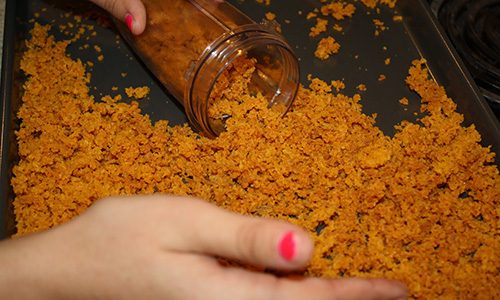 6. A Christmas gift from years ago finally came to use. It worked fantastic on grinding the eggs into a powder. My mom uses her grain mill and says it works even better.
6. A Christmas gift from years ago finally came to use. It worked fantastic on grinding the eggs into a powder. My mom uses her grain mill and says it works even better.
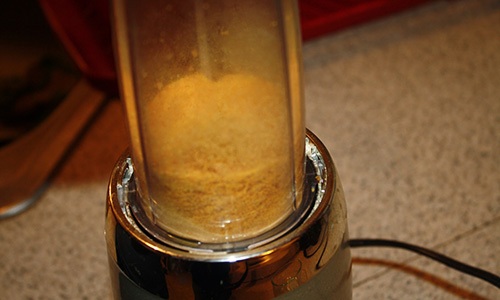 It looks just like corn meal when it’s all said and done. All eighteen eggs did not even fill up a pint sized mason jar.
It looks just like corn meal when it’s all said and done. All eighteen eggs did not even fill up a pint sized mason jar.
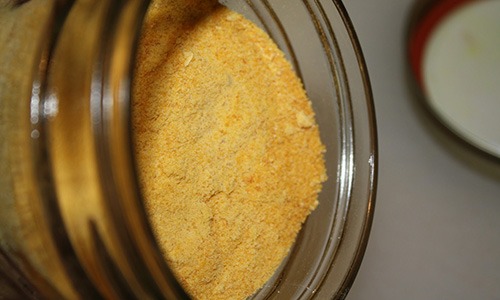 I will vacuum the jar lids to the jar and label the top with the date. All I can say is that it is about time I got it.
I will vacuum the jar lids to the jar and label the top with the date. All I can say is that it is about time I got it.
This article was gladly contributed by Jerry and first appeared on http://moderndayredneck.blogspot.com/. Jerry is a middle aged Redneck that had to start life over at 40. He says “This time I’m going to get it right!”.
You may also like:
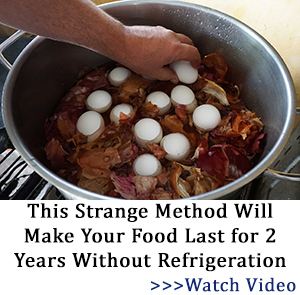 How To Stockpile Lard, The Calorie Rich Survival Food Of The Great Depression
How To Stockpile Lard, The Calorie Rich Survival Food Of The Great Depression
The Bunker Food You Need To Have Right Now (Video)
Is it Safe to Drink Old Stored Water?

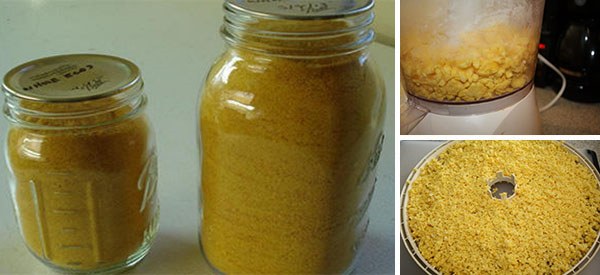













Thanks for the information. This is a must for anyone regardless if they are being just prepared or an apocalyptic prepper.
How do you vacuum the jar lids to the jar and would a coffee grinder work in place of a grain mill?
Thanks for your answer.
Sandra
How do you “ vacuum the jar lids to the jar”? Do you mean put them in a pressure canner? If so for how long and at what pressure?
Can you use an oxygen absorber in the jar, as I have no way to vacuum the air out.
Yes. I dried duck eggs and used mason jars, adding both dry packs and oxygen absorbers. And they lasted for at least the two years I got up to with no issues.
How do you use the dried eggs. Can you re-scramble? Use in sauces or cakes?
That is my question. How do you use them?
Powdered Eggs are cheap, lightweight, nutritious and can last up to 10 years without refrigeration. If it weren’t for their lack of Vitamin C, (nutritionally) a person could basically subsist for years only on powdered eggs.
Powdered eggs should be stored in the absence of oxygen and humidity (vacuum sealed) and placed in a cool dark place. Once a container of powdered eggs has been opened, the shelf life is comparable to any other dehydrated dairy product (approx. one month).
They can be used in baked goods just like normal eggs or reconstituted and made into fluffy scrambled eggs. To reconstitute one egg (for example) mix 1 heaping Tablespoon Powder with one Tablespoon cold water and one Tablespoon Milk (water – if you don’t have milk). Then you put it in the blender for a few seconds, and cook as you usually do. This procedure takes most of the grainy out.
What was your Christmas gift from years ago that you ground the eggs with after you dehydrated them?
I have been dehydrating duck eggs for a long time. Mainly for my dogs because I don’t feed kibble. So I dry veggies, and eggs and try to keep the meat/bone fresh or frozen-fresh for the most part. I get a Pyrex type casserole dish and put non stick parchment paper in it. I put all the eggs together in a bowl and blend well with nothing in it.
I pour only eggs in the dish and cook normally. When very well done, I plop it out and let it cool a bit. Cut into small chunks and put in food processor. I use my Excalibur dehydrator (has fan) with the solid sheets on it so the small pieces won’t fall through, and dry on a medium low temp.
When you do this they will still be a beautiful bright yellow color. If your heat too high to fast they turn the burnt orange color. That does change the taste if you are eating them, albeit, my dogs won’t care if I let them go a bit long. Easy to feed as I can easily just add a tablespoon to their food, with other stuff, add a bit of water and done. And it is a great species specific diet and not nasty dry kibble… they were never meant to eat. Kibble is only fed for our convenience not for the health of the dog.
How did you cook the eggs in the pyrex, in the oven or a microwave? If in the oven, at what temp and how long?
How did you vacuumed seal the lid to the jar?
Thanks
They may have used a Food saver cap that goes over the jar and lid.
Some vacuum sealers have a hose attachment to do this
I just got a little attachment from Amazon that will vacuum seal any dry good in mason jar large or small mouth in 20 seconds. Used it on beef jerky just yesterday.
Vacuum sealers have an attachment for regular and for wide mouth jars so you can vacuum seal them, I always add a moisture and oxygen absorber to my jars.
For the vacuum jar questions, check out this product:
The FoodSaver Jar Sealing Kit with Wide-Mouth Jar Sealer, Regular Jar Sealer, and Accessory Hose lets you create an airtight vacuum seal on both regular-mouth and wide-mouth mason-type jar lids.
While this is good information, and is nice to know, maybe use the web to buy some at present? Powdered eggs are readily available.
For all who questioned how to vacuum seal a jar, look at the attachments and the instructions (What? Read the instructions? That’s un-American, isn’t it). Many vacuum sealers have a jar sealing attachment and the instructions spell out how to accomplish that. (If not un-American, certainly unmanly. Womenfolk shouldn’t have any inadequacy feelings reading instructions.)
You can vacuum seal a jar in the oven, too. Fill up the jar/s to about a 1″ air space on top. Put the lids on the jars, but without setting the rings too tightly, and heat them to around 200 F., so, 15-20 minutes in the oven. Once heated through, remove them from the oven onto a rack (cold countertops will possibly fracture the hot jars on contact), and immediately tighten the lids down securely. As they cool, the jars will develop a vacuum lock as the air inside contracts. Any lids that don’t “pop” downwards, didn’t seal properly.
For those who have their own chickens, water glassing is another way to store fresh, whole eggs in the shell. The eggs must be unwashed for this method, so it won’t work on store bought eggs that are pre-washed.
https://m.youtube.com/watch?v=bTlcCvvUjl0
buy a home freezedryer from Harvest right. You can do eggs and anything else in it including meat. put in a jar and an oxygen absorber, and it will seal.
They are absurdly overpriced and require a lot of amps when off the grid with house batteries. They appear to be junky made structure and no justification for the extreme price. My dehydrator is more practical.
It is NOT a good idea to use a non-stick pan (Teflon) as the chemicals in them will absorb into to the food!! Which is very harmful!! Now your food is really no good to eat!!!
Id just dry can them in the oven after processing .